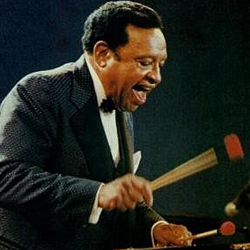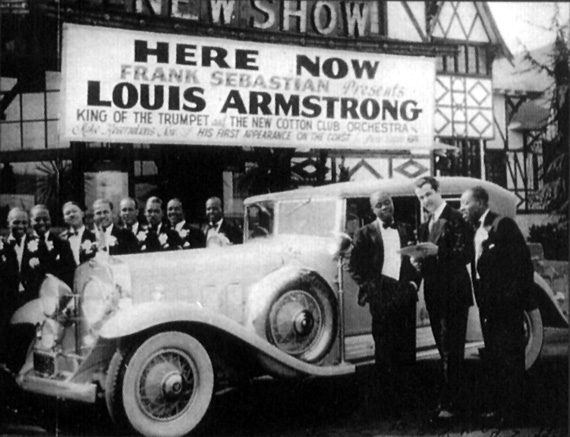
Louis Armstrong at Sebastian’s Hollywood Cotton Club. Photo courtesy dippermouth.blogspot
On October 8, 1990, The Jim Cullum Jazz Band welcomed a giant of Swing to the stage of The Landing—The Official Vibes President of the United States— Lionel Hampton.
Born in Louisville, Kentucky in 1908, Lionel Hampton was raised by his mother in Birmingham. After a move to Chicago in 1916, he began playing drums in the renowned Chicago Defender Newsboy's Band, playing alongside another Riverwalk Jazz favorite, bassist Milt Hinton.
Lionel made music his life’s work and moved to Los Angeles in 1927, where he worked with the Spikes Brothers, and made his recording debut with Paul Howard's Quality Serenaders in 1929. Hamp was a house musician at the popular nightspot Sebastian's Cotton Club in Culver City, when he first met Louis Armstrong in 1930. Armstrong’s star was on the rise and he’d been brought in from Chicago as a headliner to front the Cotton Club Orchestra, conducted by Les Hite.
Hampton’s drumming with the band really knocked out Louis Armstrong, who nicknamed him “Gate” because “the kid could really swing” (like a gate). Little did Louis know that Lionel admired his singing so much he would walk the streets without a coat on freezing winter nights, hoping to catch a cold and develop a raspy voice like his idol.
It wasn’t long before Louis Armstrong took the New Cotton Club Orchestra into the studio to back him up on a recording for the Okeh label.
Jim Cullum and his Band play three classic Armstrong numbers that Lionel recorded with Louis in 1930: “I'm a Ding Dong Daddy from Dumas,” “You're Driving Me Crazy” and “Memories of You.” Lionel tells the story behind the recording of “Memories of You” on our broadcast. Fooling around on a break in the session, Hampton came across a vibraphone used to signal NBC radio and television network ID breaks—the familiar three resonant tones of the NBC audio logo. The tale goes that Louis happened to hear Hamp swinging away on the vibes; on the spot Armstrong decided to use Hampton on vibes for the by-now legendary opening to “Memories of You.” Lionel Hampton went on to become the first prominent player of the vibes in jazz. He made the instrument his signature sound and established the vibes as a popular jazz instrument.
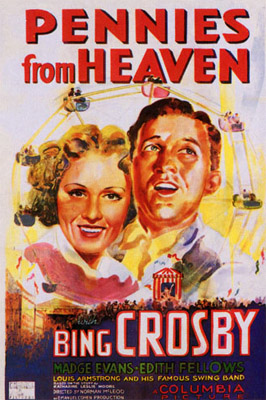
Pennies From Heaven poster from 1936 Columbia Pictures film.
During this period, Hamp studied music at the University of Southern California, and in 1934 he formed his own band, working in Oakland and Los Angeles and appearing in the film Depths Below. Hamp also appeared on screen as the ‘’masked drummer’’ with Louis Armstrong in the classic film Pennies from Heaven.
In 1936 everything changed. Playing at the Paradise Cafe in Hollywood with his band, through the machinations of mega-producer John Hammond, Lionel first met and jammed with Benny Goodman. The result was the birth of The Benny Goodman Quartet—with the unique sound of Teddy Wilson on piano, Gene Krupa on drums, Benny Goodman on clarinet and Lionel Hampton on vibes.
Hamp became a star overnight, playing vibes with Goodman's Quartet from 1936 through 1940 and occasionally playing drums with Goodman’s big band. On our radio show, Lionel Hampton praises Benny Goodman and lauds the Quartet as the first instance of an integrated group performing publicly in jazz. There had been a history of jazz recordings made with integrated groups where artists used pseudonyms to avoid racial backlash.
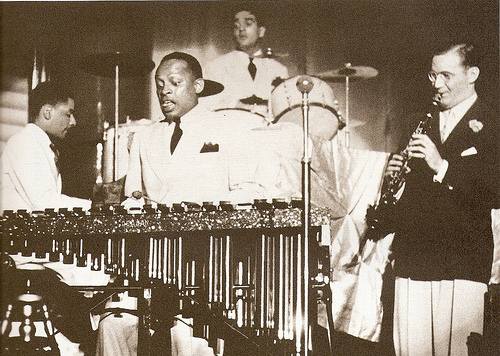
The Benny Goodman Quartet. Photo courtesy last.fm
With Goodman, Hampton recorded the classic small combo sides he performs here with The Jim Cullum Jazz Band—“Limehouse Blues,” “Avalon,” “Moonglow,” “7 Come 11,” and his big band number “Flyin' Home.” On our show, Hamp explains how he composed “Flyin’ Home” in honor of his fear of flying in airplanes and adopted the number as his theme song. The arrangement heard here was created for the broadcast and features an expanded band with saxophonists Fred Salas and Cullen Offer, and lead trumpet player Mike Berglund.
.jpg)
1944 Lionel Hampton & Orchestra "Flyin' Home" Original Trade Booking Promo Ad.
About Benny Goodman Hampton says, “You had to be very punctual when you played with Benny. You had to have your hair combed, your shoes shines, your suit pressed, and come there with the brightness to play the best performance you can on your instrument on that day at that time. I liked that, I think some of that rubbed off on me because that’s the kind of band I try to have every day. He was a wonderful guy, I learned a lot from him.”
Lionel Hampton regularly led his own touring and recording bands from 1937 onward. In 1940 he moved back to Los Angeles and formed his own big band. Beginning in 1953 he toured Europe, Japan, Australia, Africa, the Middle East, etc. Hamp appeared in the 50's film The Benny Goodman Story. In 1978, he was featured at President Jimmy Carter's White House Jazz Party.
Over the ensuing years, Hampton’s big bands featured many players who would go on to prominence in jazz, among them Arnett Cobb, Illinois Jacquet, Clifford Brown, Quincy Jones, Dizzy Gillespie, Charles Mingus, Wes Montgomery, Dinah Washington and many others. In the 1940s and 50s Hampton recorded in small combos with Stan Getz, Art Tatum and others.
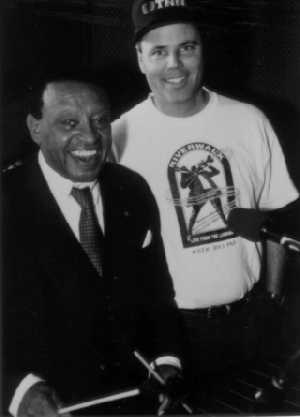
Lionel Hampton and Riverwalk Jazz Host David Holt at The Landing.
At the time of our show, Hampton was 83 years old, still leading and touring with his own big band and performing arrangements such as the popular “Sweet Georgia Brown” performed here with The Jim Cullum Jazz Band.
Lionel Hampton died in 2002 in New York City.
Photo credit for Home Page: Lionel Hampton photo courtesy jazzprofessional.com
Text based on Riverwalk Jazz script by Margaret Moos Pick ©1990


